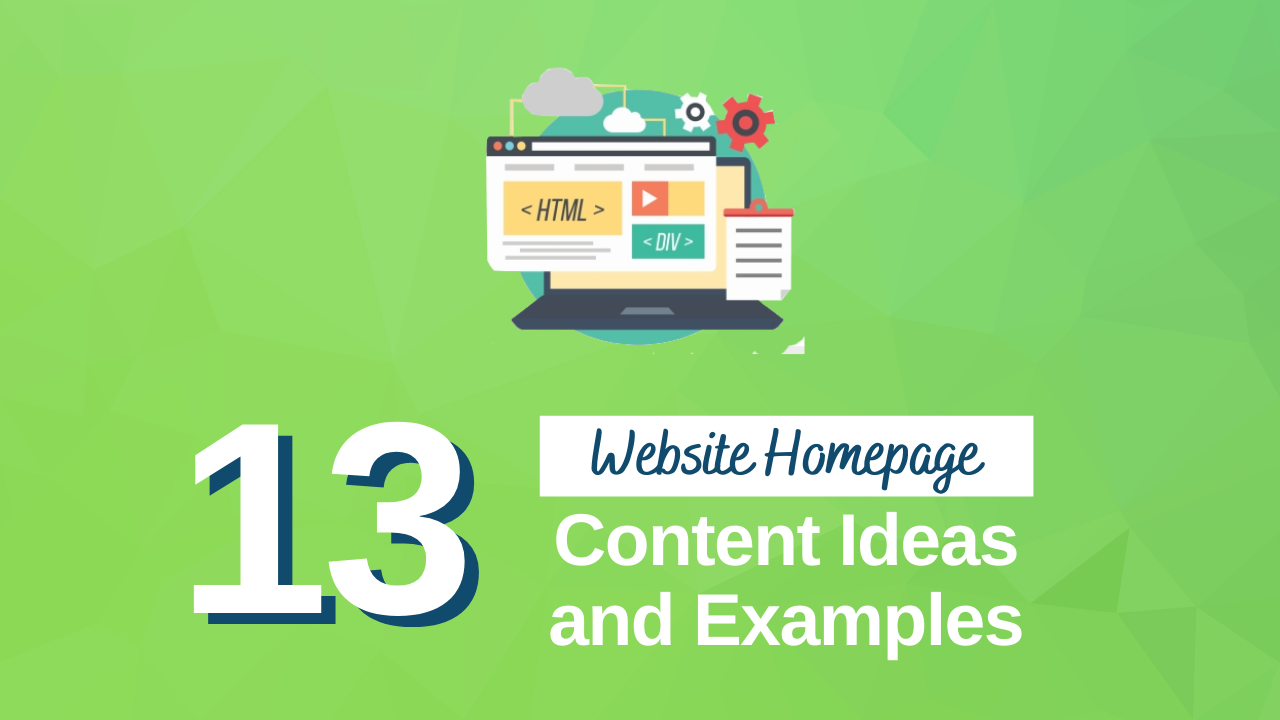
13 Website Homepage Content Ideas And Examples
What is a website homepage?
A homepage (or home page) is the main web page that appears when someone visits your website. Think of it as the lobby of your website. It should be clean, easy to navigate, and welcoming to your prospective customers.
The homepage of a website is the first thing that a visitor sees when they visit it. It is also the first opportunity for you to make a great first impression.
Why create content for your website homepage?
Your homepage content needs to clearly communicate who you are, who you help, and how you help them. You need to be able to capture your visitors’ attention within 5 seconds, otherwise they may leave and never come back.
Your content is more important than the homepage design because visitors don't come to your website for how it looks. They come to find out if you can solve their problems and help them achieve the results they are searching the web for.
Only content can communicate your message, educate your visitors, and persuade them to purchase your products and services over your competition. Web design can’t do that.
Here are some of the most important reasons to create content for your homepage:
- Homepage content encourages visitors to stay on your site longer.
- It helps surface relevant information about your business, products, and services.
- The homepage can be used as an opportunity to tell the story behind your business or brand.
- It provides an overview of what you offer.
What should you put on your website homepage?
At Copywriting Crew, our team of professional Native English writers have written high-quality content for hundreds of websites in over 153 different industries.
In that time, we’ve discovered there are 13 best practices you should follow when creating your homepage content.
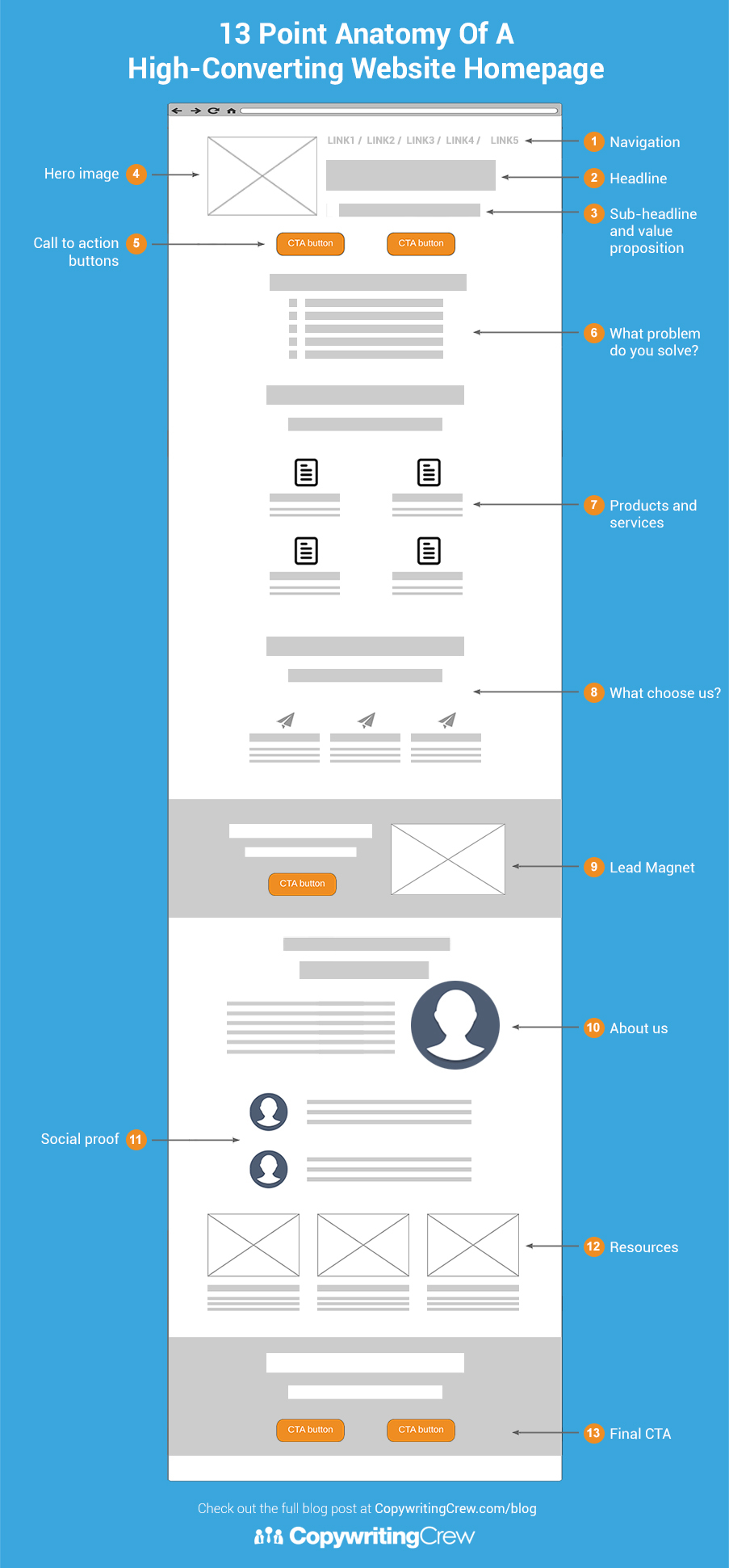
13 Point Anatomy of A High-Converting Website Homepage
1. Navigation
Navigation is a key part of a website. It helps the visitor find their way around and provides a sense of order and direction. The navigation should be clear, easy to use, consistent and benefit the user experience.
More over, the navigation should also be intuitive. A visitor should not have to think about how to get from one page to another or where they are in the site hierarchy. They should be able to easily find what they are looking for without any confusion.
Here are our website navigation best practices…
- Make it easy for visitors to find what they are looking for.
- Include links to your money pages (products, services, etc.).
- Menu item text should be short and descriptive.
- Limit the number of menu items in the top navigation to 7 or less.
- Position your navigation menu at the top of your website (not below).
- Be sure to include your logo and link it to your website homepage.
- It’s important to include links to your Contact and About pages.
Here is the menu navigation bar from our own Copywriting Crew website.

Navigation bar of CC
2. Headline
Your homepage headline is the first thing visitors are going to read. If it’s weak or confusing, people won’t stick around to read the rest of your web page. According to Moz.com “On average, 8 out of 10 people will read headline copy, but only 2 out of 10 will read the rest”.
In addition, your headline should be written to get the attention and interest of your ideal clients (not everyone). It should be specific, clear and easy to understand within 5 seconds.
Here are 3 headline writing formulas for homepage headlines.
- What the website is about and who it’s for
- What you do and who you help
- The benefits the visitor can expect
Headline Example: ‘what it is’ and ‘who it’s for’
Website: www.CampaignMonitor.com
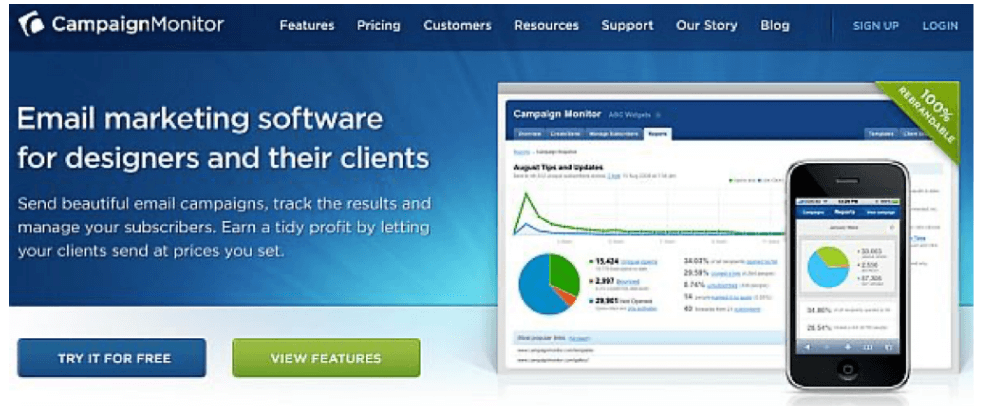
Campaign Monitor Headline
Headline Example: ‘what it is’ and ‘who it’s for’
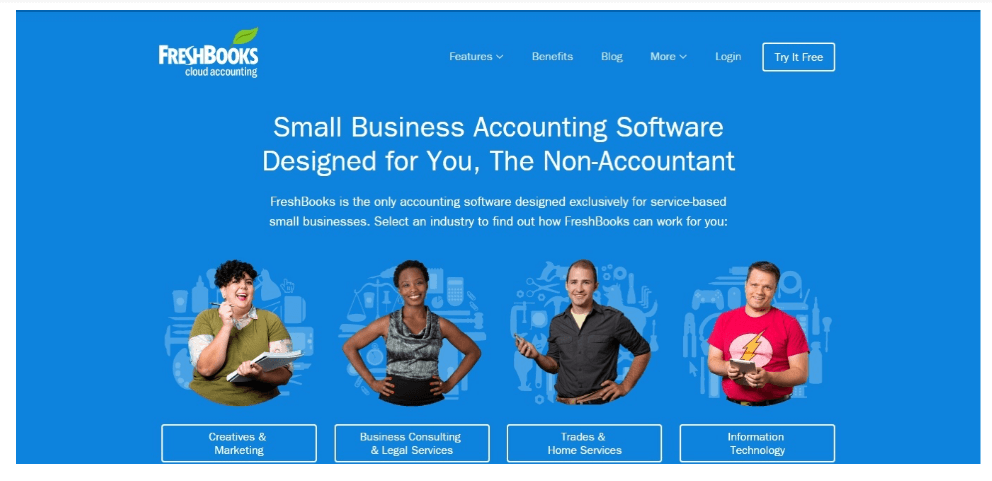
FreshBooks Headline
Headline Example: ‘what you can do with it’
Website: www.CopywritingCrew.com.au (hey, that’s our website!)
Copywriting Crew Headline
3. Sub-headline and value proposition
The sub-headline is the short paragraph directly underneath the headline.
Therefore, the goal is to further explain the headline and also to state the value proposition.
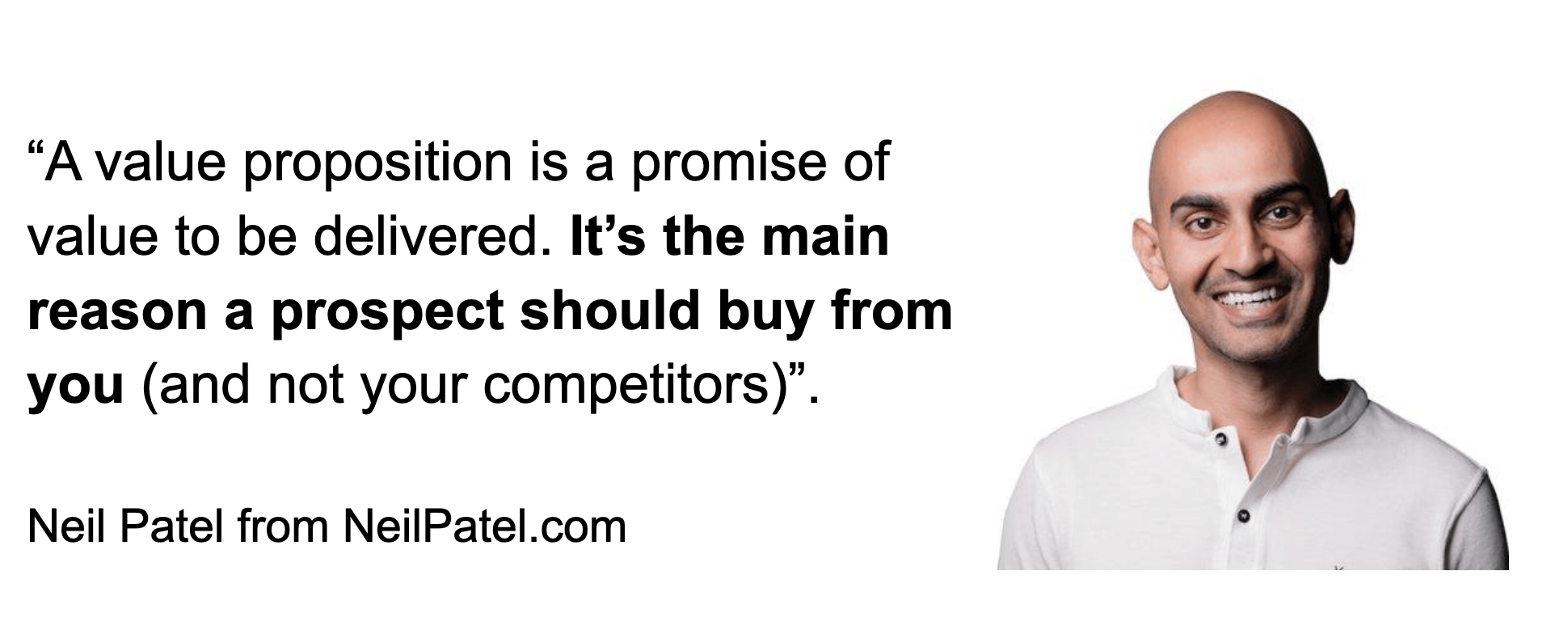
Neil Patel Sub-headline
What is a value proposition? Here’s how famous digital marketer Neil Patel answers that question.
So how do you come up with a value proposition? The best way is to directly answer the question “Why should I choose you over the competition?”
Therefore, your answers should be unique and something that your competitors can’t claim. You can make your value proposition more compelling by including numbers.
Here are a couple of value proposition examples.
Website: www.webmerge.com

Webmerge Value Proposition
Website: www.Trello.com
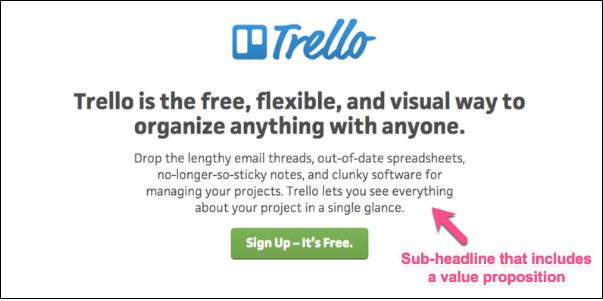
Trello Value Proposition
4. Hero Image
Your hero image is the first image people see when they visit your website homepage. It should be eye-catching and make a great first impression.
Moreover, your hero image should visually represent what your website is about. If your website is about something negative like lung cancer, then you wouldn’t use an image of a smiling person (an image of someone in hospital would be more suitable).
Avoid stock images where possible. The problem with using stock images is that they are everywhere and don’t seem genuine or unique. Try to use photos of real people (your satisfied staff, actual clients, etc) instead of inauthentic stock photos.
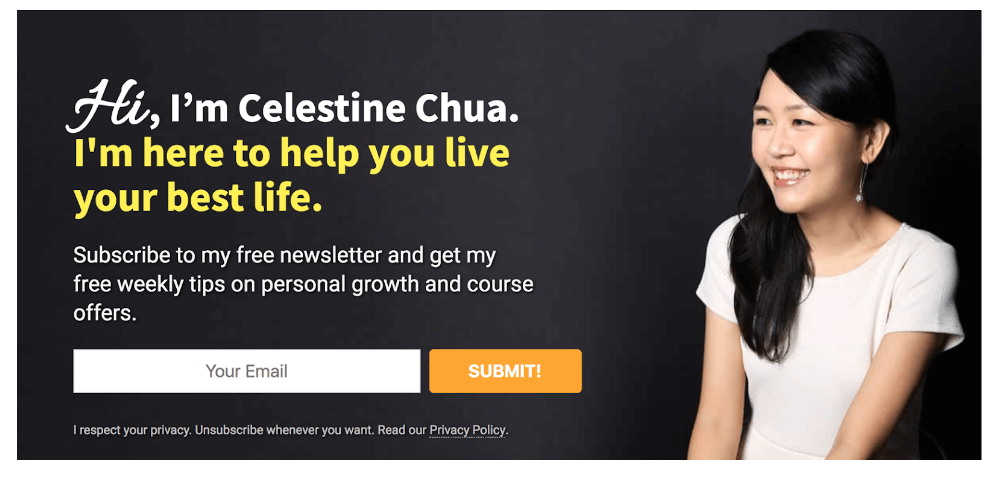
Celestine Chua Hero Image

Square Hero Image

Snack Nation Hero Image
5. Call to action button
A call to action (CTA) button prompts visitors to take the primary action you want them to take. You position the CTA buttons below your headline and sub-headline in the above-the-fold area of your homepage.
I recommend having a maximum of two call to action buttons. You can always add more buttons and links further down the page.
When deciding on what call to action button(s) to include, ask yourself:“What’s the single most important action I want visitors to take on my homepage?”
Our clients will often reply by saying “I want them to purchase our products” or “I want people to enquire about our services”.
Once you’ve decided on the one or two actions you most want people to take, the next step is to write your call to action button copy. Here are a few best practices you can follow when creating yours.
Write no more than 5 words.
Use verbs like ‘get’ or ‘shop’.
Inspire action with words like ‘now’ or ‘today’.
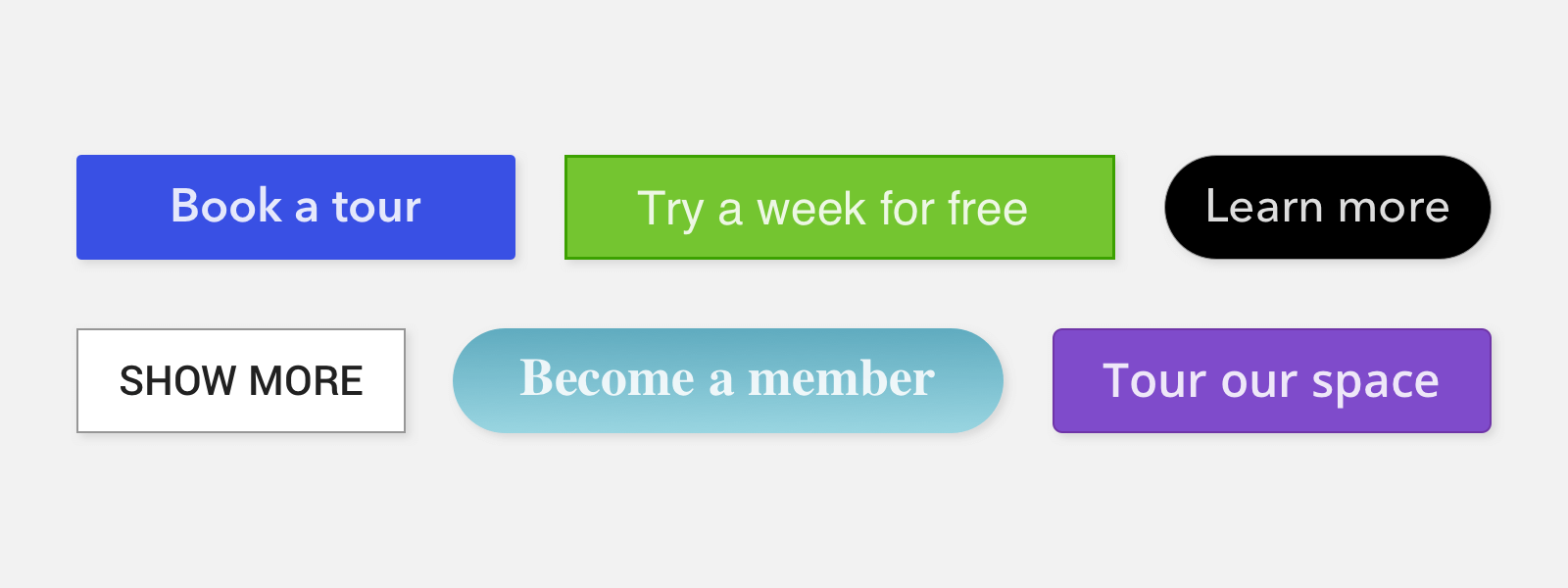
Call To Action
For websites that sell services…
- Request Free Quote
- Get In Touch Now
- Order Content Today
For websites that sell products…
- Shop Superfoods
- View Products
- More…
6. What problem do you solve?
People are searching for solutions to their problems online.
And one of the most powerful copywriting techniques is to show your target audience that you understand their problems on a deep level. When you bring up their problems, you create an immediate rapport with your readers. You also pique their curiosity — “how does he/she know this about me?”
The simple way of doing this is by asking a series of problem-related questions (or statements) that you know the target audience will answer “yes” to. And by reminding them of their problems, you put them in a “I have problems and I need a solution” state of mind, which is perfect timing for the next step: introducing the solution. Here’s two examples of the problem-solution framework in action…

Businessblueprint.com example
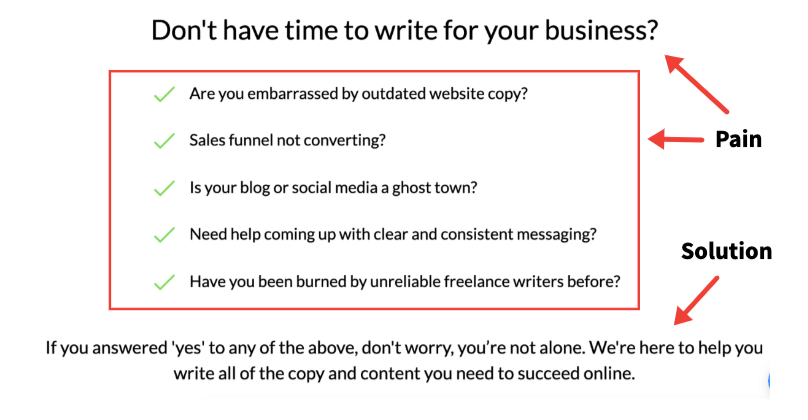
CopywritingCrew.com example
7. Products and Services
Most websites have separate pages dedicated to each of the products and services they offer. Your homepage can have a section where you provide a short description about each product or service and a link for visitors to click on that will take them to another page where they can read more about it.
Here are our best practices for writing the products/services section:
Write a heading that captures the visitor's attention.
Write a subheading that mentions the main benefits of the products/services.
And write a short benefit-focused description about each product/service.
Examples of products/services section:
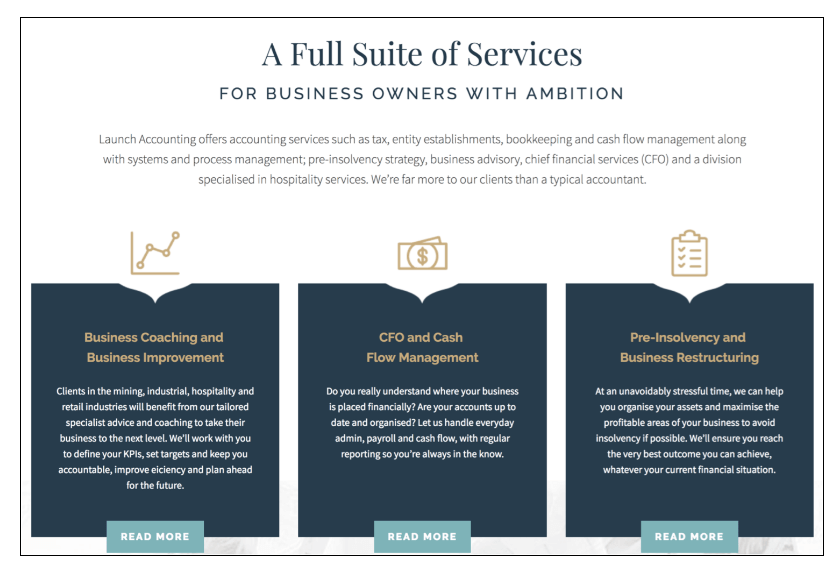
Launchaccounting.com.au
8. Why Choose Us?
Reports show that online shoppers typically compare three different companies at the same time before making a buying decision.
That’s why it’s important to answer the question “why should I choose you and not your competitors?” Here are a few best practices for writing this section.
Try to list between 4 and 6 unique reasons (meaning, your competitors can’t make the same claims) and write a simple headline and short paragraph for each reason.
Moreover, be specific by including numbers (“Our depreciation reports are the most accurate” is not as specific as “Our depreciation reports are 99.99% accurate”).
Here are some examples…
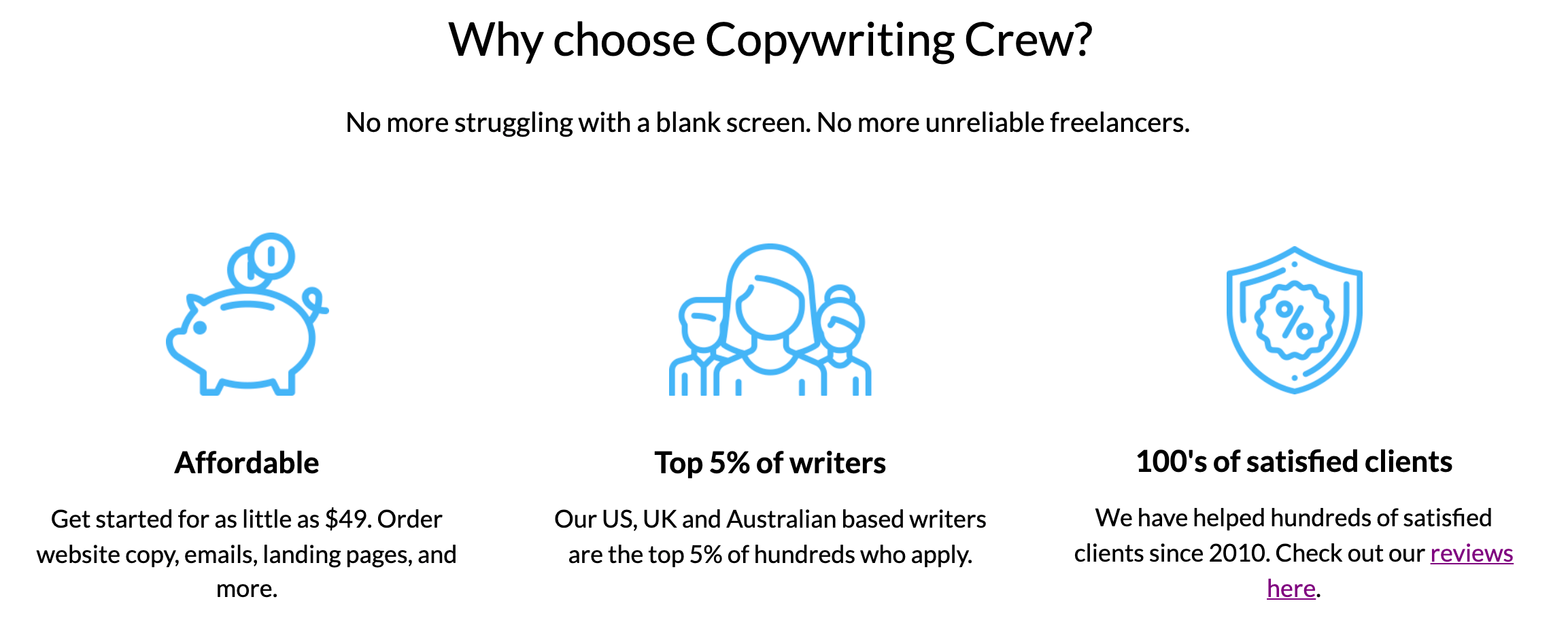
CopywritingCrew.com example
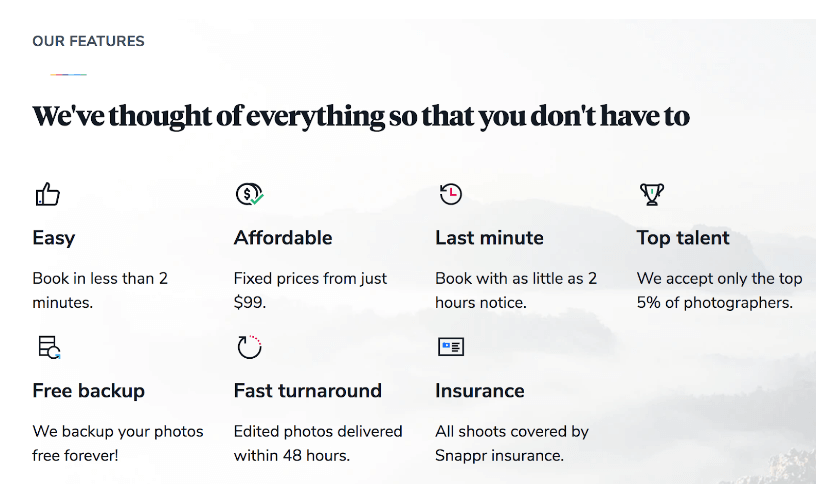
Snappr.com example
9. Lead Magnet
Most first-time website visitors are not ready to buy right away. 98% of your website visitors are leaving without engaging at all (according to Meetedgar.com).
A ‘lead magnet’ is a valuable piece of content (like a video, report, spreadsheet, webinar, etc.) or even a ‘discovery call’ or ‘strategy session’ that helps your ideal customers achieve a result or solve a specific problem.
In addition, you offer your visitors the lead magnet for free in exchange for their contact information (first name and email address) so you can keep in touch and build a relationship until they are ready to buy from you.
Popular types of lead magnets:
Ebook
Mini guide
Checklist
Template
Webinar
Free consultation
Video
Free assessment
Free quote
Your lead magnet doesn’t need to be a comprehensive 100-page ebook or guide. It’s not also a blog post. Who has time to read those anyway?
It could be a 1-page checklist, template or script. Or a 5-page how-to guide that reveals a few essential steps or tips.
Moreover, your lead magnet title should be clear and specific, not vague and unclear. It should mention either the problem you help them to solve or the result you help them achieve.
Here are a few lead magnet examples to inspire you.

KKwrites.com Lead Magnet
Example 2:
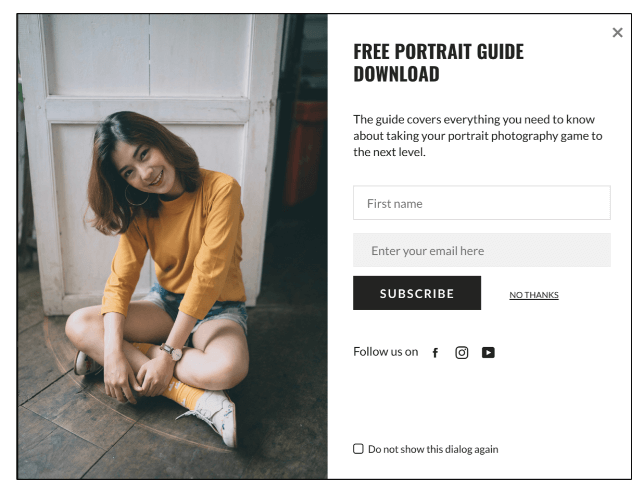
SeanDalt.com Lead Magnet
10. About Us
The About Us section of your homepage is your opportunity to briefly introduce yourself, your business and your team to potential customers. You can provide a link to your about page where people can find out more information.
In addition, the purpose is to allow visitors who are scanning the homepage to have this impression: “Oh, this is a real business with real people working there”.
Here are our best practices for writing the About Us section:
Tell your business founder’s story.
Even though you’re writing about the company, remember to always relate it back to the visitor and how what the company does benefits them.
Include professional and smiling photos of you and team members.
11. Social Proof
The ‘Social Proof’ section of your homepage is where you provide credible third-party sources that show visitors that you are trustworthy and credible.
Social proof in the online marketing context is evidence that other people have purchased and found value in a product or service offered by a business (source, optimizley.com).
People are more likely to believe others who say we are trustworthy than when we say it ourselves.
There are many different types of social proof elements you can include on your website homepage, such as.
Testimonials
Awards
Certifications
Client logos
One of the most effective types of social proof is customer testimonials (written or video). However, not all testimonials are created equal. We want to avoid using boring, long-winded or vague testimonials. The BEST testimonials typically include:
Specific result or benefits the person achieved or received
The person’s full name, photo (if provided) and specifics about who they are (occupation, location, job title, website address, etc.)
Get to the point (not long-winded or rambling)
Here are some examples of homepage testimonials:

Testimonial Example
12. Resources
The ‘Resources’ section of your homepage is an opportunity to showcase valuable content that positions you as an expert in your field, answers common questions, and educates people about the benefits of your products and services.
You might hand-pick a selection of your top three blog posts. Or an informative white paper report. Or perhaps an insightful webinar recording or video interview.
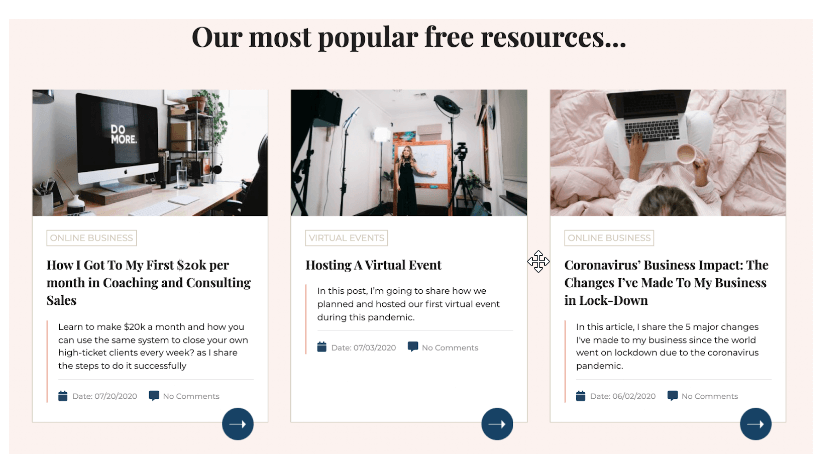
Thedoersway.com example
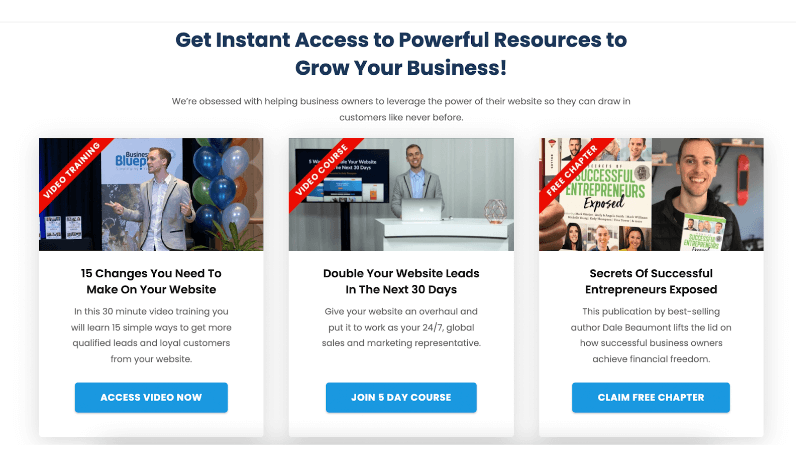
lightningsites.com example
13. Final CTA
The ‘Final CTA’ section is located at the bottom of your homepage and its purpose is to remind visitors about the call to action(s) you want them to take.
Did you know that the second-most-viewed part of any web page is the very bottom (the top being the first)? The reason is that visitors will scan and scroll down a web page until they reach the bottom and can’t scroll any further.
Therefore, the bottom of the page is a great place to repeat the goal of your page, the CTA (Call To Action), and to remind the visitor of the main benefits your business is offering.
Here are our best practices for writing the Final CTA section
Write an attention-getting heading (e.g., Ready To…?).
Write a subheading that explains the benefits of taking the next steps.
And write a CTA button that matches the one below the headline at the top of the page.
Here are some examples of great Final CTA section copy:

LaunchAccounting.com example
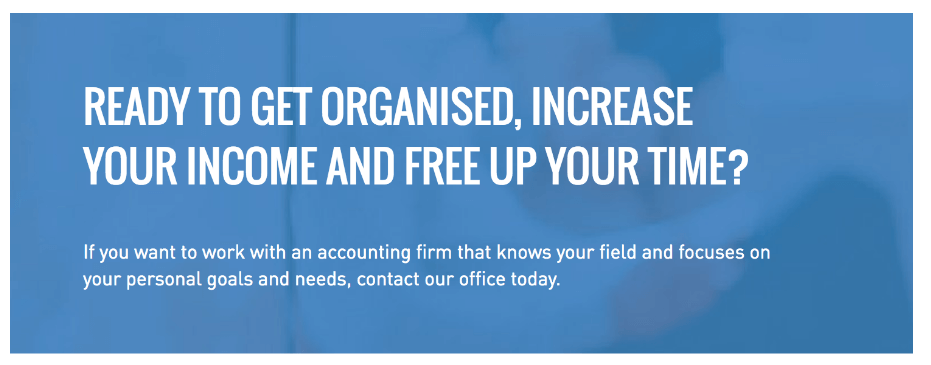
CTA Example 2
Need Help Writing Your Homepage Content?
If you’re like many business owners, entrepreneurs and digital agency owners, you just don't have time to sit down and write website content for your business.
But don't worry, we can help!
At Copywriting Crew, we have already helped hundreds of business owners in 153 different industries create unique and high-quality content for their websites.
So whether you're looking to launch a brand new website or update an existing website, we would love to help you save time and money by writing all of the content for your business and marketing campaigns. Simply order your custom content by clicking here and our team of professional Native English writers will get started right away.Frequently asked questions
Can you share some of the best website homepage examples?
Absolutely! You can check out our website copywriting portfolio, where we have many homepage examples that will give you content ideas and may even inspire your own homepage design!
Can you give me some website homepage content ideas?
Here are the top x elements we recommend you include on your website homepage.
What should you put on a website homepage?
Can you give me some website homepage content ideas?
Here are the top 13 elements we recommend you include on your website homepage.
Navigation
Headline
Sub-headline and value proposition
Hero Image
Call to action button
What problem do you solve?
Lead Magnet
About Us
Social Proof
Resources
Final CTA
Relevant Links
10 Great Website Copywriting Examples You’ll Want To Copy In 2022
How much does website copywriting cost in 2022?
The Ultimate Guide to Website Copywriting for Beginners In 2022
